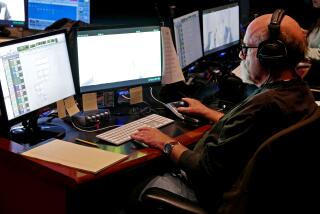Audio System Designer: Have Ear, Will Travel
- Share via
WASHINGTON — With guns blazing, Mel Gibson and Danny Glover careen in a station wagon through traffic-clogged streets in pursuit of a fleeing bad guy, but Lewis Lipnick is too busy talking acoustics to notice.
Oblivious to the screeching tires, wailing sirens and thunderous gunshots in the opening scene of “Lethal Weapon 2,” Lipnick is explaining the sonic dynamics of the $100,000 audio-laser disc system on which it’s playing.
“There are other people who design systems, but no one does it this way,” said the 46-year-old Lipnick, standing amid washing machine-sized speakers in a client’s converted attic room in upscale McLean, Va.
“You have to know the acoustics from both the hall and from the stage,” added Lipnick, who has played contrabassoon in the National Symphony Orchestra for the last 22 years.
Lipnick’s small Silver Spring, Md.-based business, Your Silent Partner, strives to bring symphony-hall sound to clients’ living rooms so “you can almost see the sweat on the musicians’ brows and the resin clouds rising off the strings,” he said.
But people who hire the red-bearded Lipnick, or “Lip” as his friends call him, get more for their money than an electronics freak who knows tweeters from woofers. They’re also getting a classically trained musician with an ear for hire.
Offstage, he writes about high-tech, high-priced audio equipment for Stereophile magazine, where he is musician in residence.
The rest of the time, Lipnick zips around Washington in his gray Jeep Cherokee--and even as far afield as Oregon, Texas and Alaska--offering advice on customized audio and video systems.
His clients include fellow musicians and wealthy professionals.
During an initial $500, three-hour consulting session, he helps them determine what kind of sound system meets their musical needs while staying within the constraints of their budget. For $150 an hour after that, he helps them buy and install it.
Systems he has designed have ranged in price from $1,000 to $400,000 and have been equipped mostly with U.S.-made components, which Lipnick and other experts say are still the best at the high end of the price scale.
Despite the profusion of Japanese brand names at most shopping mall audio stores, “the best stuff and the most expensive stuff, almost all of it is American,” said Larry Archibald, publisher of Stereophile, a slick journal that is considered a bible for true audio aficionados.
A working musician for two decades, Lipnick doesn’t sell equipment, or even get a commission on the components and wiring he recommends.
Many of the components he installs are sleek, futuristic and look more like sculptures. They carry names like Apogee and Parasound and four-figure price tags.
This is equipment that can re-create a sound so true it “makes your heart swell and the hair stand up on your arm like you’re at a concert,” said Joyce Flemming, executive director of the Academy of High-End Audio, a San Diego-based trade group for the pricey end of the industry. It’s also a field where American companies excel.
Mass-produced equipment from “Japan completely dominates the world mid-size market, but if you want something designed by ear and built by hand, it’s usually American,” Flemming said.
She said there are few sales statistics available for the 200 or so U.S. companies that make high-end audio equipment, roughly defined as systems that reproduce the effect of live music--usually at a minimum price of $1,000. Industry numbers are sketchy because most are small, privately owned firms that grew up around a single innovative designer, much like the early computer companies of Silicon Valley.
“As best we can guess, the American product is somewhere in the neighborhood of $400 million a year,” Flemming said.
Commerce Department data appears to back that up, said Cynthia Upson of the Electronics Industry Assn. The consumer electronics trade group, which plans to survey manufacturers for the first time this year, believes that the $792.3 million in audio loudspeakers, amplifiers and other components exported in the first nine months of 1992--the most recent period for which figures are available--was mostly high-end equipment manufactured here.
Describing himself as a kind of musical architect, Lipnick acts like a musical physician--diagnosing clients’ needs by inquiring about the symptoms of their musical passion.
His “diagnosis by exclusion--figuring out what won’t work”--includes a detailed questioning of his clients’ musical tastes, from how often they go to concerts to where they like to sit.
Lipnick’s clients also gain entree to his wide-ranging contacts in the music and audio business.
“When you live in Oregon, you don’t have access to certain kinds of stuff,” said Dr. Cameron Wiley, a Salem, Ore., radiologist who paid Lipnick about $850 for his services several years ago. “I ended up getting equipment from several different dealers in Washington, Virginia and Denver. These were acquaintances of his, so I could just call them up and tell them what I wanted.”
A graduate of Baltimore’s Peabody Conservatory, Lipnick first became interested in audio as a teen-ager. He helped broadcast concerts from the prestigious Interlochen Arts Academy in Michigan.
About that same time, he took up the bassoon and later the bigger, heavier contrabassoon, an admittedly “oddball instrument that reflects my infatuation with the unusual,” said Lipnick.
Describing the double-reed instrument as a piece of plumbing that can make a loud blatting noise somewhere between a Bronx cheer and “someone with intestinal distress,” Lipnick sees the lighter side of longhair music.
More to Read
The biggest entertainment stories
Get our big stories about Hollywood, film, television, music, arts, culture and more right in your inbox as soon as they publish.
You may occasionally receive promotional content from the Los Angeles Times.










